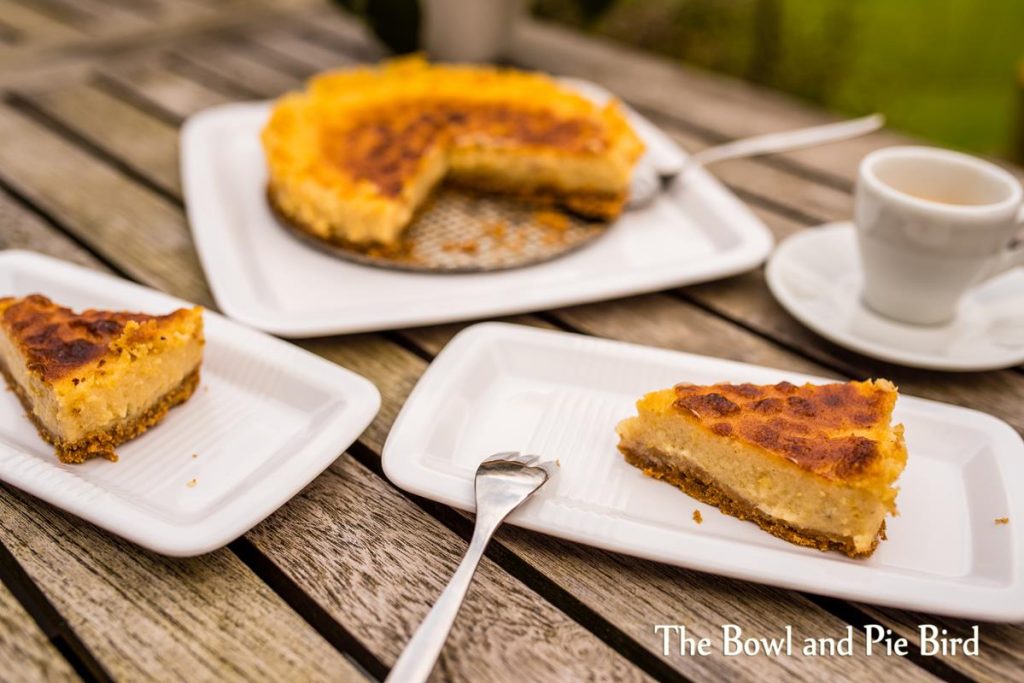Als Hans-Dampf-in-allen-Gassen probiere ich gern alles aus. Außerdem ist es m.E. auch alles eine Frage der Erziehung, der Gewohnheit und der persönlichen Perspektive. Wenn man z.B. wegen Allergien keine Milchprodukte verträgt, dann ist die vegetarische und vegane Küche normal und nicht exotisch. Also öfter mal einen Blick über den Tellerrand riskieren und sich überraschen lassen. Nun aber zu dem Käsekuchen. Mich erstaunt immer wieder wie erfinderisch die vegane Küche ist. So z.B. dass man aus Kichererbsen-Wasser Baiser machen kann! Hier der Blogeintrag zu diesem Rezept
Nun gibt es Käsekuchen, die mit Tofu gebacken werden und auch die No-Bake Varianten, bei den man z.B. Cashewnüsse über Nacht in Wasser einweicht, fein püriert und diese Creme dann als Füllung nimmt. Aber ich wollte einen warmen Käsekuchen und die Tofuvarianten klangen anhand diverser Rezeptrezensionen nicht so toll. Und dann bin ich auf dieses Rezept von Sara von Love Nonpareille gestoßen, und es klang fantastisch! Die Geheimwaffe Kichererbsen Baiser macht den Kuchen auch sensorisch zu einem Meisterwerk. Das Vermischen des Joghurts (ich habe Vanille genommen) mit der aufgeschlagenden Zucker/Margarine war etwas schwierig, da ich auch nach intensivem Rühren Klümpchen in der Masse hatte. Diese sind aber beim Backen weggeschmolzen. Da es am Sonntag schnell gehen sollte, habe ich auch keinen Mürbeteig gebacken, sondern einen Keksboden aus 100 g Keksen, 50 g Margarine und 1 Prise Salz zubereitet. Unten in der Springform flach drücken und in den Kühlschrank stellen, während ihr die Füllung vorbereitet. Die Springform war ziemlich voll und da ich Angst hatte, das etwas überläuft, habe ich unter dem Gitter ein Backblech mit Backpapier gelegt. Das war auch gut so, denn etwas Margarine vom Keksboden ist ausgelaufen. Nach 45 Minuten war der Kuchen schon recht braun, so dass ich ihn mit Alufolie abgedeckt für die restlichen 15 Minuten habe backen lassen. Der Kuchen muss auf jeden Fall gut durchkühlen, damit er schnittfest wird. Mein Mann und ich haben ihn noch ein wenig lauwarm gegessen. Die Konsistenz war wie ein fester Pudding. Der Geschmack: Fantastisch! Vanillig, zitronig und da die Oberfläche so lecker knusprig war, schmeckte es fast wie Crema Catalana.

Rezept: http://www.lovenonpareille.com/der-beste-schnellste-vegane-kaesekuchen/
English
As a Jack-of-all-trades type of girl I like to try out everything. Also in my opinion it’s a lot about upbringing, habits and personal preferences. If you suffer from allergies and can’t eat milk products for example then the vegetarian and vegan kitchen will be normal and not exotic to you. So take the risk! Think outside the box more often and be surprised. But back to the cheesecake. I am always astounded how inventive the vegan kitchen is. I mean making meringue out of chick pea brine! Here my post on that recipe.
Well, there are cheesecakes baked with tofu and the no-bake ones around. With the latter you soak cashew nuts in water overnight, purée them and use this cream as a filling. But I wanted a warm cheesecake and the tofu ones didn’t sound – I read a few recipe comments – too grand. And then I came across this recipe from Sara from Love Nonpareille and it sounded fantastic. The secret weapon chick pea meringue makes this cake a sensory masterpiece as well. Mixing the yoghurt with the creamed sugar and margarine was difficult in the sense that even after having stirred the mixture for quite a bit it still had small lumps. But these melted away whilst baking. As I was pressed for time on Sunday I didn’t make a shortcrust pastry base, but made one instead with 100 g crushed biscuits, 50 g margarine and a pinch of salt. Press firmly into the spring pan base and put in the fridge whilst preparing the filling.
The baking tin was pretty full and I was worried that it would overflow so I lined a baking tray with baking paper and placed it underneath. Luckily I did as some margarine came out of the biscuit base. As the cake was quite brown after 45 minutes I covered it with aluminium foil for the remaining 15 minutes.
The cake definitely has to cool completely to make it firm enough to cut. My husband and I ate the cake whilst it was just a little lukewarm. The taste: Amazing! Vanille, lemon and as the surface was so cripsy it tasted nearly just like Crema Catalana.

Recipe: http://www.lovenonpareille.com/der-beste-schnellste-vegane-kaesekuchen/
[:]
Update July 2020:
The original recipe (in German) is now available under this link: http://www.happyplanties.de/der-beste-schnellste-vegane-kaesekuchen/
I’ve translated the recipe now too for you. The cake is baked in a spring-release baking tin. The size isn’t mentioned in the recipe I’ve just noticed but I used my 20cm diameter tin which was the reason why the tin was so full. Next time I’ll use the 24cm diameter tin.
Pastry: The recipe uses a normal shortcrust pastry made out of 200 g all-purpose flour, 100 g (vegan) margarine, 50 g sugar, a pinch of salt and 3 tbsp cold water. But feel free to use your favourite shortcrust pastry recipe for this cake as it’s the filling which makes this cake so tasty.
Filling
– 100 g vegan margarine
– 120 g sugar
– 500 g soya yoghurt (choose one with no flavour, lemon or vanilla as you prefer)
– 40 g custard powder
– ½ organic lemon (zest and 1 tbsp juice)
– 1 pinch of salt
– 120 ml aquafaba
– 1 tsp baking powder
Preparation
– Prepare your shortcrust pastry. Blind bake for 10 minutes or as your recipe instructs.
– The cake itself is baked at 180°C
– Add sugar and margarine into your mixer (I used the paddle attachment) and beat together until smooth and creamy.
– Add the soya yoghurt and mix again.
– Slowly add the custard powder and mix
– Add the zest of the lemon and the lemon juice
– Add the salt
– Mix until everything is well incorporated.
– Beat the aquafaba in a high bowl just like you would egg whites. When it starts to stiffen and peak add the baking powder and continue to beat until the mixture is really firm.
– Gently fold it under the yoghurt mixture with a spatula.
– Pour the mixture into your prepared baking tin and bake for about 60 minutes.
The cake will still be quite wobbly but will firm up when it is completely cooled.



